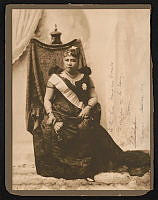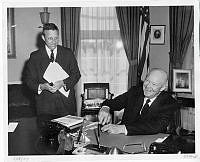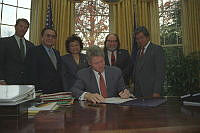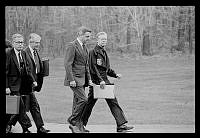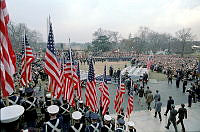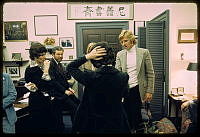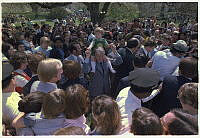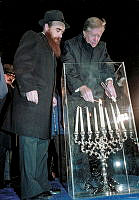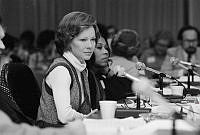Lighting the White House
Copyright © April 16, 2014 White House Historical Association. All rights reserved under international copyright conventions. No part of this article may be reproduced or utilized in any form or by any means, electronic or mechanical, including photocopying, recording, or by any information storage and retrieval system, without permission in writing from the publisher. Requests for reprint permissions should be addressed to books@whha.org
Designed to be lit in the way common to the world at the beginning of the nineteenth century, the President’s House in 1800 had natural light streaming in through windows that stretched 14 feet high and 5 feet across. The first family and residence staff pulled tables and chairs close to the windows so they could read and write, or sew and polish silver by daylight. In the evening, lamps and candles lit the house.1 Foul-smelling lard oil, readily available and cheap, made from animal and vegetable fats, fueled the lamps. Candles came in many types; common ones burned down to stubs and were melted to make new ones. The household reserved tall, graceful tapers associated with the age of candlelight for formal occasions. The State Rooms had overhead chandeliers that burned candles, the safest way to light the crowded reception rooms. Large oil lanterns burned in the hallways.2
Thomas Jefferson and James Madison made use of the Argand lamp, an innovative oil lamp that burned six times brighter than candles.3 Candles provided overhead light until Andrew Jackson installed small glass lard-oil lamps in the East Room chandeliers. Gas lighting made its appearance in 1848, during the administration of James Polk, who had gas lines piped to the chandeliers on the State Floor. First Lady Sarah Polk was not enthusiastic about gas lighting and insisted that the Blue Room chandelier still hold candles for its softer light. On the night the new gaslights debuted in the state rooms, a gas supply outage plunged the rooms into darkness. Mrs. Polk’s preference for candles saved the evening. Gaslight soon became more dependable, and by the Civil War, was the primary artificial light source for the White House.4

Argand Lamp, c. 1830, one a pair owned by Dolley Madison.
White House Historical AssociationA redecoration of the East Room carried out in 1873-74 for President Ulysses S. Grant added the glow and shimmering light of massive gas chandeliers. As the twentieth century opened, the room’s opulent Victorian décor, then ridiculed as “steamboat Gothic,” gave way to the Beaux-Arts style in 1902. The great crystal gasoliers, installed in anticipation of Nellie Grant’s wedding in 1874, were transferred to the United States Capitol in 1903.5

The East Room chandeliers in 1889.
Library of CongressElectricity came to the White House in 1891, during the Benjamin Harrison administration. Planned as part of a well-funded project for wiring the State, War, and Navy Building (today’s Eisenhower Executive Office Building) next door, the electrical work at the White House was installed by the Edison Company. A generator for both buildings was put in the State, War, and Navy Building’s basement, with the wires strung across the lawn and introduced into the White House under the conservatory.6 The relatively new method of illumination was initially intended to be only a supplement to gaslight, but one after another, rooms were lit by electricity. Wires were buried in the plaster, with round switches installed in each room for turning the current on and off. By the time Theodore Roosevelt took office, use of electric light was common in American houses. The entire wiring system was replaced during the major restoration of the White House in 1902. Only the service areas of the house retained their gaslight fixtures, and these were used only in case of a power failure.7
For the 1902 Theodore Roosevelt Beaux-Arts renovation of the White House, the architects McKim, Mead & White commissioned Edward F. Caldwell and Company of New York to provide lighting fixtures. The most spectacular were three massive electric chandeliers hung in the East Room made of cut glass and gilded brass by Christoph Palme & Co., Parchen, Bohemia (Austria-Hungary). Only a year later the chandeliers were taken down and “the diameter of the lower portion reduced in size.” They were shortened and modified again during the Truman renovation (1948-1952). Each chandelier currently consists of about 6000 pieces of glass and weighs about 1200 pounds.8
Another well-known Caldwell light fixture, added to the White House North Portico in 1902, is a distinctive wrought iron and glass lantern. It hangs serenely under the floodlit North Portico and creates the glowing backdrop for the nightly televised news reports of White House correspondents.

The White House lit up at night, 2005.
White House Historical AssociationThe White House has had its share of electrical upgrades since 1902. The wiring was completely replaced during the Truman renovation. There have been continuous updates to the White House electrical system and, on occasion, experiments. In 1979, Jimmy Carter installed solar panels on the roof of the West Wing over the Cabinet Room to heat the water supply for the White House staff mess.9 The panels were removed in 1986 during roof repairs. Solar panels did make a comeback at the White House in 2014 and were added to the main roof to create a renewable energy source.
The conservation of the White House historical lighting fixtures that preserve the history of lighting in the executive residence (including many 18th and 19th century glass chandeliers, sconces, and candelabra) is the important task of the White House Curator’s office. The White House Collection includes “twenty-one chandeliers – two on the Ground Floor, nine on the State Floor (including the three massive fixtures in the East Room), and ten on the Second Floor.”10
The White House Historical Association, as part of its mission to preserve the White House, provides funding for the conservation of these light fixtures and assists in the interpretation of the historic legacy of lighting the Executive Mansion.

The East Room chandeliers in 2000.
White House Historical Association












